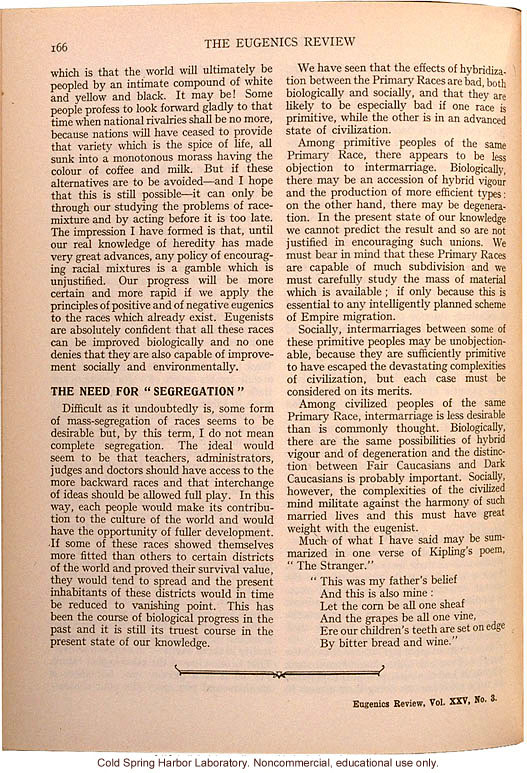166
The Eugenics Review
which is that the world will ultimately be peopled by an intimate compound of white and yellow and black. It may be! Some people profess to look forward gladly to that time when national rivalries shall be no more, because nations will have ceased to provide that variety which is the spice of life, all sunk into a monotonous morass of having the colour of coffee and milk. But if these alternatives are to be avoided - and I hope that this is still possible - it can only be through our studying the problems of race-mixture and by acting before it is too late. The impression I have formed is that, until our real knowledge of heredity has made very great advances, any policy of encouraging racial mixtures is a gamble which is unjustified. Our progress will be more certain and more rapid if we apply the principles of positive and of negative eugenics to the races which already exist.
Eugenists are absolutely confident that all these races can be improved biologically and no one denies that they are also capable of improvement socially and environmentally.
The Need For "Segregation"
Difficult as it undoubtedly is, some form of mass-segregation of races seems to be desirable but, by this term, I do not mean complete segregation. The ideal would seem to be that teachers, administrators, judges and doctors should have access to the more backward races and that interchange of ideas should be allowed full play. In this way, each people would make its contribution to the culture of the world and would have the opportunity of further development. If some of these races showed themselves more fitted than others to certain districts of the world and proved their survival value, they would tend to spread and the present inhabitants of these districts would in time be reduced to vanishing point. This has been the course of biological progress in the past and it is still its truest course in the present state of our knowledge.
We have seen the effects of hybridization between the Primary Races are bad, both biologically and socially, and that they are likely to be especially bad if one race is primitive, while the other is in an advanced state of civilization.
Among primitive peoples of the same Primary Race, there appears to be less objection to intermarriage. Biologically, there may be an accession of hybrid vigour and the production of more efficient types: on the other hand, there may be degeneration. In the present state of our knowledge we cannot predict the result and so are not justified in encouraging such unions. We must bear in mind that these Primary Races are capable of much subdivision and we must carefully study the mass of material which is available; if only because this is essential to any intelligently planned scheme of Empire migration.
Socially, intermarriages between some of these primitive peoples may be unobjectionable because that are sufficiently primitive to have escaped the devastating complexities of civilization, but each case must be considered on its merits.
Among civilized peoples of the same Primary Race, intermarriage is less desirable than is commonly thought. Biologically, there are the same possibilities of hybrid vigour and of degeneration and the distinction between the Fair Caucasians and Dark Caucasians is probably important. Socially, however, the complexities of the civilized mind militate against the harmony of such married lives and this must have great weight with the eugenist.
Much of what I have said may be summarized in one verse of Kipling's poem, "The Stranger."
[extract]"This was my father's belief
And this is also mine:
Let the corn be all one sheaf
And the grapes be all one vine,
Ere our children's teeth are set on edge
By bitter bread and wine."
[centered graphic rule]
Eugenics Review, Vol. XXV, No. 3
[end]


